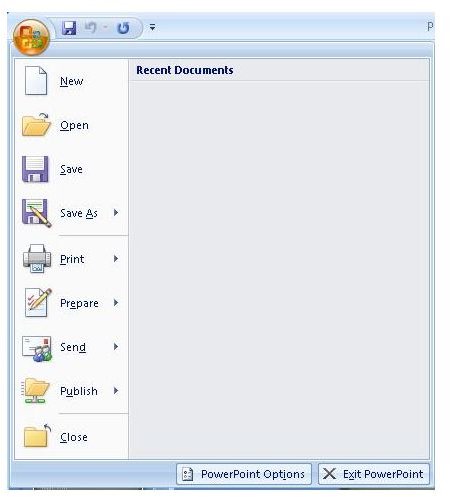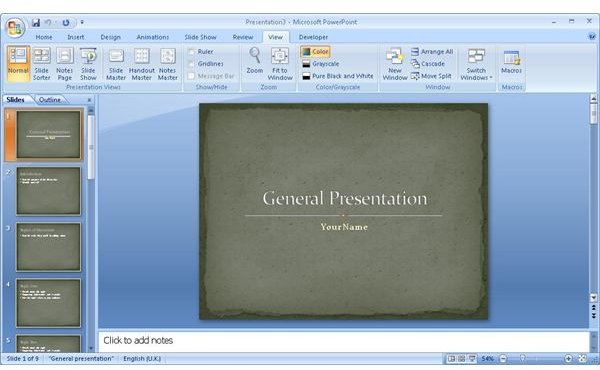A Lesson Plan for PowerPoint: Level 1 Introductory
Learning Outcome 1: Using the PowerPoint Application
At end of a basic training course in PowerPoint, a learner should be able to navigate their way around the PowerPoint application.
This will include being able to open and close PowerPoint; to use the ribbon interface and the Microsoft Office button; to use keyboard shortcuts to speed up common tasks; to set up the application using basic options and preferences; to use different magnifications using the Zoom function; to switch between different views and tabbed ribbons; to access the slide master view and the different presentation outline views at the left hand side
Powerpoint 2007


Learning Outcome 2: Managing Presentations
A learner should be able to manage presentations. This will require them to work with presentations and to:
- open and close presentations from the Microsoft Office button or Close Window button or by using keyboard shortcuts [Ctrl]-O and [Ctrl]-[F4];
- create a new presentation based on the blank template from the Microsoft Office button or using keyboard shortcuts[Ctrl]-N;
- create a new presentation based on installed themes from the Microsoft Office button or from sample templates available from Microsoft Office Online
- save the current presentation to the current name and folder from the Microsoft Office button or by using keyboard shortcuts [Ctrl]-S;
- save the current presentation to a different name, folder or file format from the Microsoft Office button;
- check a presentation using the spelling option on the Review tabbed ribbon or the [F7] keyboard shortcut;
- print a presentation from an installed printer using default options from the Microsoft Office button or by using keyboard shortcut [Ctrl]-P;
- print a presentation from the Microsoft Office button using a range of options:entire presentation, specific slides, handouts, notes, number of copies, collate, change the default printer;
- publish as an Acrobat (pdf) file from the Microsoft Office button: remove metadata.
Learning Outcome 3: Creating Slides
A learner should be able to create slides based upon text. This will require them to:
- be able to find characters on the QWERTY keyboard ;
- toggle between insert and overwrite mode using the Insert key;
- insert symbols from the button on the Insert tabbed ribbon;
- display or hide non-printing characters from the button on the Home tabbed ribbon;
- switching case using the Aa button on the Home tabbed ribbon or using the [Shift][F3] keyboard shortcut;
- select a character, word, line, sentence, paragraph, or text back to start or from cursor to the end, or the entire text, using the mouse or keyboard shortcuts;
- find a specific word, phrase, or special character using the Find option on the Home tabbed ribbon, or the [Ctrl]-F keyboard shortcut;
- replace a specific word, phrase, or special character using the Replace option on the Home tabbed ribbon, or the [Ctrl]-H keyboard shortcut;
- copy and move text within a presentation within the same presentation and between open presentations using drag and drop or the clipboard zone of the Home tabbed ribbon, or using the [Ctrl]-C, [Ctrl]-V or [Ctrl]-X keyboard shortcuts;
- delete a character, word, line, sentence, paragraph, or text back to start or from cursor to the end, or the entire text, using the [Del] key with selected text or keyboard combination
- use the undo and redo functions from the arrows above the ribbons or the keyboard shortcuts [Ctrl]-Z or [Ctrl]-Y;
- change the text formatting, including font sizes, font types, bold, italic and underline, subscript, superscript, font colour using the Home tabbed ribbon, or keyboard shortcuts eg [Ctrl]-B, [Ctrl]-I or [Ctrl]-U;
- add remove or format bullets, numbers in a single level list; switch between different standard bullet, number styles in a single level list using the buttons on the Home tabbed ribbon;
- change the borders and shading options: add a box border and shading/background colour to a paragraph using the buttons on the Home tabbed ribbon;
- use the format paintbrush tool: apply an existing character style to selected text or paragraphs using the format paintbrush tool button on the Home tabbed ribbon.
A further training program will equip learners to handle tables, images and charts, and multimedia and to add slide transitions and animations.
For more on Powerpoint, look out for more intermediate lesson plan, or try my book The Art of Presenting or my articles on PowerPoint 2003 Getting Creative with PowerPoint.
